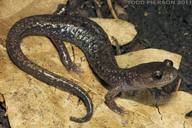|
Aneides hardii (Taylor, 1941)
Sacramento Mountains Salamander Subgenus: Aneides | family: Plethodontidae subfamily: Plethodontinae genus: Aneides |
| Species Description: Taylor, E. H. 1941. "A new plethodont salamander from New Mexico." Proceedings of the Biological Society of Washington 54, 77–79. | |
 © 2011 Todd Pierson (1 of 14) |
|
|
|
Description DESCRIPTION: (A description of species morphology as if you had the amphibian in your hand, typically starting with the snout-vent length, then focusing from the head to the body and extremities) Aneides hardii is a plethodontid salamander from south-central New Mexico, United States of America, with a snout-vent length ranging from 40 - 58 mm. Females are typically smaller than males, having an average snout-vent length of 44.5 mm compared to 48.4 for males. Total length ranges from 25.5 - 100.7 mm, with tails being slightly shorter than the snout-vent length. In males especially, the temporal region on the head is enlarged by the jaw muscles. The trunk and tail are round. There are 14 or 15 costal grooves, with 2 - 4.5 between appressed limbs. The digits are short, with four digits in each forelimb and five in each hind limb. The toe tips are somewhat rounded (Scarpetta 2019). DIAGNOSIS: (How this species is differentiated from similar species) COLORATION: (In life and/or in preservative) In life, the dorsum is blackish-brown or brown with greenish-gray to bronze mottling and gold flecks (Scarpetta 2019).VARIATION: (if known) The three populations of A. hardii on the Capitan, Sacramento, and White Mountains, each have differences in average snout-vent lengths and average snout-vent lengths relative to average tail length. However, these values overlap enough to make individuals’ original populations unidentifiable (Scarpetta 2019). Among Aneides, A. hardii has the most sexually dimorphic snout-vent length and snout length. Males generally have a longer snout-vent length and wider head width (Staub 2020). Lastly, the largest adults may lack the greenish mottling on the dorsum. Juveniles may have a bronze-brown dorsal stripe (Scarpetta 2019). Distribution and Habitat Country distribution from AmphibiaWeb's database: United States U.S. state distribution from AmphibiaWeb's database: New Mexico
Life History, Abundance, Activity, and Special Behaviors Mating occurs underground in June. Oviposition occurs once every three years in June and July. Eggs hatch during August and September, during which most of the annual precipitation occurs. Aneides hardii egg clutches contain 4.7 eggs on average and eggs have a diameter ranging from 6.4 - 9.1 mm. Females brood the eggs. Of Aneides, A. hardii produces some of the smallest clutch sizes and the largest eggs (Williams 1978). Larva Trends and Threats Comments PHYLOGENETIC RELATIONSHIPS: From Bayesian and Maximum Likelihood analyses on the nuclear genes recombination activating gene 1 (RAG1), brain-derived neurotrophic factor (BDNF), and proopiomelanocortin (POMC), A. hardii is sister to the clade composed of A. ferreus, A. flavipunctatus, A. iecanus, A. klamathensis, A. lugubris, A. niger, and A. vagrans (Staub 2020).Analysis of cyt B mtDNA showed three genetically distinct lineages for the three A. hardii populations (on the Capitan, White, and Scaramento Mountains). The isolation of these three populations is due to geographic barriers as well as the sedentary lifestyle of A. hardii (Osborne 2019). ETYMOLOGY (Origin or explanation of scientific name): Aneides hardii is named after Dilbert Elmo Hardy, the original collector (Scarpetta 2019).
References
Haan, S.S., Desmond, M.J., Gould, W.R., Ward, J.P. (2009). "Influence of habitat characteristics on detected site occupancy of the New Mexico endemic Sacramento Mountains Salamander, Aneides Hardii." Journal of Herpetology, 41, 1-8. [link] Osborne, M.J., Cordova, S.J., Cameron, A.C., Turner, T.F. (2019). "Isolation by elevation: mitochondrial divergence among sky island populations of Sacramento Mountain salamander (Aneides hardii)." Conserv Genet, 20, 545-556. [link] Scarpetta, S.G. (2019). "Aneides hardii." Catalogue of American Amphibians and Reptiles, 921, 1-23. [link] Staub, N.L. (2021). "The evolution of derived monomorphism from sexual dimorphism: a case study on salamanders." Integrative Organismal Biology, 3(1), obaa044. [link] Stebbins, R. C. (2003). Western Reptiles and Amphibians, Third Edition. Houghton Mifflin, Boston. U.S. Fish and Wildlife Service (1994). "Animal candidate review for listing as endangered or threatened species." Federal Register, 59(219), 58995. [link] Williams, S. R. (1978). "Comparative reproduction of the endemic New Mexico plethodontid salamanders, Plethodon neomexicanus and Aneides hardii (Amphibia, Urodela, Plethodontidae)." Journal of Herpetology, 12(4), 471-476. [link] Originally submitted by: Kevin Gin (first posted 2004-04-27) Description by: Madeline Ahn (updated 2022-11-30)
Distribution by: Michelle S. Koo, Madeline Ahn (updated 2022-11-30)
Life history by: Madeline Ahn (updated 2022-11-30)
Larva by: Madeline Ahn (updated 2022-11-30)
Trends and threats by: Madeline Ahn (updated 2022-11-30)
Comments by: Madeline Ahn (updated 2022-11-30)
Edited by: Tate Tunstall, Ann T. Chang (2022-11-30) Species Account Citation: AmphibiaWeb 2022 Aneides hardii: Sacramento Mountains Salamander <https://amphibiaweb.org/species/3937> University of California, Berkeley, CA, USA. Accessed Nov 21, 2024.
Feedback or comments about this page.
Citation: AmphibiaWeb. 2024. <https://amphibiaweb.org> University of California, Berkeley, CA, USA. Accessed 21 Nov 2024. AmphibiaWeb's policy on data use. |



 Raffaëlli Account
Raffaëlli Account Map of Life
Map of Life